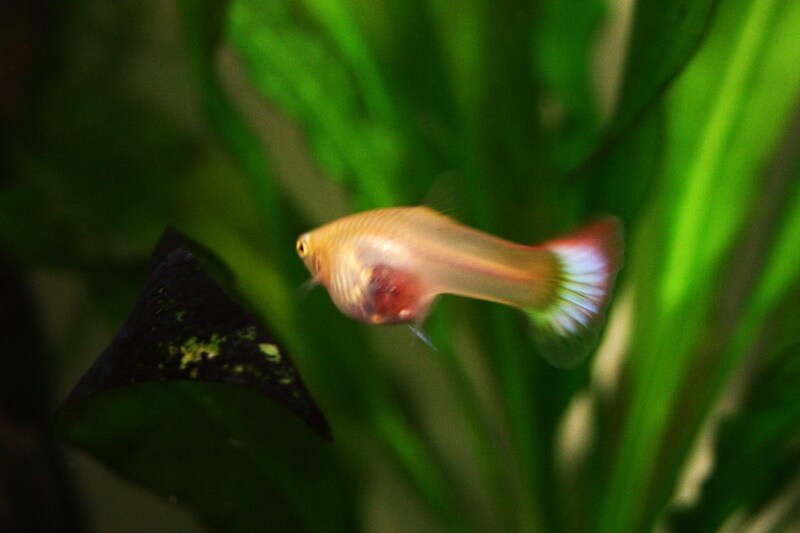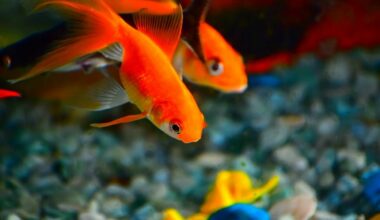Learning how to tell if a guppy fish is pregnant isn’t challenging. All it takes is a basic understanding of their biology and knowing what to look for!
This guide will teach you what a pregnant guppy looks like, and also provide some tips on how you can prepare if the miracle of life finds its way into your aquarium!
Table of Contents
How To Tell If A Guppy Is Pregnant
Guppy fish are popular livebearers with a penchant for constant breeding when conditions are right. There are many ways to tell that you have a pregnant guppy on your hands. However, several health conditions can create similar symptoms.
As a result, it’s easy to confuse sick guppies for pregnant ones. Here how to tell if a guppy is pregnant and not ill.
You Witness Mating
One of the easiest ways to know for sure that you have a pregnant guppy is by seeing the mating process firsthand.
Guppies aren’t shy about breeding. While other species require precise water parameters and environmental conditions, guppy fish are a little more flexible.

Many aquarists end up with babies without any direct intervention whatsoever! In other words, if you have males and females in the same tank, there’s a good chance that mating will occur.
So, how does breeding work with guppies?
Well, these freshwater fish are livebearers. That means the eggs develop inside the womb before the female gives birth to fully-formed babies. This fact is important because it impacts how the fish breed.
Author Note: Insemination occurs within the body, so don’t expect to see the female lay eggs as other species would.
When the conditions are right, males will initiate the mating process by chasing the females around the tank. The mating ritual can last several minutes, but the act of insemination is brief and easy to miss.
As the male gets close, he’ll extend his gonopodium. The gonopodium is a modified anal fin that looks like a thin rod. He inserts the gonopodium into the female’s anal vent to pass along a sperm packet.
You might see this act occur a couple of times as the male ensures that he successfully inseminates the female.
After that, it’s business as usual!
Mating is a quick process that most aquarists don’t even notice, and the lucky ones that do tend to mistake it for aggression. However, once you know what you’re looking for, you can easily recognize the behavior and use it as a telltale sign of a pregnant guppy fish in the coming weeks.
There Are Changes In The Appearance Of The Gravid Spot
The gravid spot is a unique physical feature that’s exclusive to livebearing females. It’s the darkened skin of the womb located just behind the anal fin. The area is usually visible in female guppies whether they’re pregnant or not because of their semi-transparent belly skin.
When the eggs are successfully inseminated, the babies start to develop in the gravid spot.

In turn, you should see noticeable changes to the spot’s appearance. It will become more prominent and darker as those babies grow. Right before birth, the area is practically black.
Author Note: As you get close to the end of the gestation period, you may even see tiny dots in the gravid spot. Believe it or not, those spots are the eyes of the babies inside!
The Belly Gets Larger
Like most pregnant creatures, female guppy fish will balloon in size as the pregnancy progresses. The change in size does not happen overnight. It’s a slow process that takes several weeks.
Female guppies are already a bit plump as it is, but size increases due to pregnancy are a bit different. Most notably, the belly begins to bulge.
It may even take on a somewhat boxy shape. Just before the pregnant guppy gives birth, the belly might even look somewhat angular.
There are other reasons why a guppy’s belly could get bigger. Diseases like dropsy and swim bladder diseases could be to blame.
Pay attention to that gravid spot! That’s the most apparent difference between a sick and pregnant guppy.
You Notice Behavioral Changes
The signs of pregnancy aren’t just physical. Many pregnant female guppies start to exhibit behavioral changes, too.
Females tend to get pretty aggressive when they’re pregnant. While they can exhibit some feisty behavior towards any fish that gets in her way, pregnant females tend to direct most of their anger at the males.
That’s because males will often keep trying to mate with her even after she’s pregnant.
The aggression usually starts with the females chasing the males. If it progresses, females might even resort to fin nipping!
As the gestation period winds down and the fish is about to give birth, you’ll notice some more extreme behavioral shifts.
The first is a new aversion to food. A guppy tends to avoid eating shortly before birth. If they do eat, you might see them spit the food back out later.
The pregnant female will start looking for places to hide as well. She’ll become missing in action as she attempts to find a peaceful spot to give birth.
Author Note: Guppy fish are vulnerable to attack when giving birth, so they seek out quiet areas to avoid issues from other fish. Not only that, but more sparse parts of the tank improve the chances of survival for the babies.
Towards the end of the pregnancy, guppies will also go through some involuntary actions. They include labored breathing and body convulsions.
The Length Of The Gestation Period
The gestation period for guppy fish isn’t long at all. On average, the babies develop in the womb for about 21 to 31 days. In some rare cases, gestation might last as long as 35 days.
Several factors will determine the exact range. Everything from the water temperature to the availability of food will come into play. The same goes for the fish’s overall health.
The actual birthing process is much shorter. It only lasts between two and six hours.
It’s important to maintain good tank conditions when caring for pregnant guppy fish. Incorrect water parameters could delay the gestation period. In severe cases, environmental factors can terminate the pregnancy altogether.
Keep the tank clean and monitor conditions regularly. Guppies can give birth in standard tropical tank conditions, but things need to remain stable to ensure the mother’s health.
How Many Babies Can You Expect?
How many babies you’ll end up with depends on many different factors. Pregnant guppies can give birth to anywhere between 10 and 50 baby fish!
Genetics, the availability of food, the mother’s health, and a bit of luck will determine the exact number.
Age is a significant factor, too. Younger fish giving birth for the first time tend to have fewer babies in the beginning. The fry is often smaller and weaker as well.
As she gets older and continues to mate, the female guppy fish usually has more and more babies with every pregnancy.
Now, there are no guarantees about the survival rate. Some babies are bound to die shortly after birth. Whether that’s from getting eaten by other fish or through natural causes, getting a 100 percent survival rate is rare.
Some babies might even come out stillborn.
Again, the age of the mother is a big determining factor. Older fish with some experience tend to have smoother pregnancies than those who are still young.
Author Note: An impressive fact is that guppy fish can get pregnant pretty quickly after giving birth. Females can have a new batch of babies every month! Regular breeding fish can easily give birth to well over 2,000 babies in their lifetime!
How To Prepare For The Baby Guppies
If you want to maximize survival rates, there are some steps you need to take in preparation for the upcoming birth.
Once you’re able to tell that the female guppy fish is pregnant, consider moving her to a separate breeding tank. This isn’t a requirement, but it can make a huge difference.
Being separated from the rest of the fish will reduce stress tremendously. Furthermore, it’ll give the babies a fighting chance at survival.
You don’t need a massive breeding tank. In fact, a small 10-gallon aquarium will do.
Alternatively, you can use a breeding box within a larger tank.

Whatever you do, make sure that the babies have a way to hide and escape from getting eaten. Even the mother will attempt to eat her young.
Many breeder boxes have slanted bottoms for the fry to fall through after leaving the womb. You can also invest in some breeding mesh.
Fine-leaf plants work well, too. Plants like Java moss, hornwort, and guppy grass provide plenty of coverage and security for fry. Many aquarists even see decent survival rates with these plants for babies born in community tanks.
When they emerge from the womb, babies are usually curled up in a ball. Healthy ones will start swimming after sinking to safety. Remove any stillborns to keep the rest healthy.
To keep those babies well-fed, you need to make sure you have the right food on hand.
Baby guppy fish are considerably larger than most fish that hatch from eggs. As a result, they can eat larger foods right out of the womb.
The best food is baby brine shrimp. It’s high in protein and fat, so prepare a batch just before the mother gives birth.
You can also cultivate infusoria. As a last resort, powdered fish food is adequate as well.
Be prepared to raise the guppies separately for about two to three months. At that point, they are sexually mature and ready to join larger community tanks.
Conclusion
As you can see, there are a number of simple ways you can tell if a guppy is pregnant or not. After reading this guide, you shouldn’t have any trouble!
Let us know if you have any other questions about the process or need help determining if you have a pregnant guppy fish or not. We’re always happy to help.

